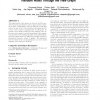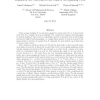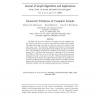592 search results - page 37 / 119 » Crossing numbers of random graphs |
SIGECOM
2006
ACM
14 years 1 months ago
2006
ACM
Braess’s Paradox is the counterintuitive but well-known fact that removing edges from a network with “selfish routing” can decrease the latency incurred by traffic in an eq...
CP
2004
Springer
14 years 1 months ago
2004
Springer
Many backtracking algorithms exhibit heavy-tailed distributions, in which their running time is often much longer than their median. We analyze the behavior of two natural variant...
WWW
2008
ACM
14 years 8 months ago
2008
ACM
The rapid growth of the number of videos in YouTube provides enormous potential for users to find content of interest to them. Unfortunately, given the difficulty of searching vid...
SODA
2012
ACM
11 years 10 months ago
2012
ACM
Given a class of graphs F, we say that a graph G is universal for F, or F-universal, if every H ∈ F is contained in G as a subgraph. The construction of sparse universal graphs ...
GD
1998
Springer
14 years 5 days ago
1998
Springer
We define the geometric thickness of a graph to be the smallest number of layers such that we can draw the graph in the plane with straightline edges and assign each edge to a lay...



